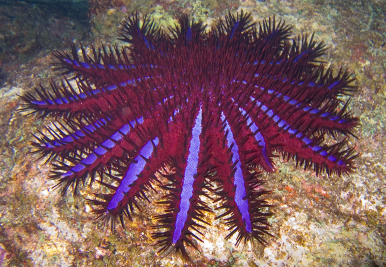Crown of Thorns starfish II
0
Overview
Using this Resource
Connecting to the Curriculum
Marking Student Responses
Working with Students
Further Resources
This task is about how observations inform theories.
Over the past 20 years outbreaks of the Crown of Thorns starfish have caused large amounts of damage to coral reefs in the Pacific Islands. Crown of Thorns starfish feed on the fast growing corals of the coral reefs.

Scientists wanted to work out why Crown of Thorns starfish have become such a problem.
One theory suggests that when there are fewer predators starfish numbers increase.
Copyright:

Crown of Thorns (Acanthaster planci). Koh Similan, Boulder City, Thailand.
Date Taken on November 25, 2005.
Source http://www.flickr.com/photos/jonhanson/89930167/
Author jon hanson on flickr.
Permission
(Reusing this file)
CC-BY-SA-2.0
Level:
5
Curriculum info:
Key Competencies:
Keywords:
Description of task:
Task: Identify how features/adaptations of a starfish help it survive, and decide whether the amount of evidence from scientists' observations supports or does not support their theory/inference. Assessment focus: using observations as evidence to inform theories.
Curriculum Links:
Science capabilities
The capabilities focus is brought about by the conversations you have and the questions you ask.
The capabilities focus is brought about by the conversations you have and the questions you ask.
Capability: Use evidence
This resource provides opportunities to discuss using evidence to support a theory.
This resource provides opportunities to discuss using evidence to support a theory.
Capability: Critique evidence
This resource provides opportunities to discuss the validity of the evidence provided.
Science capabilities:
Answers/responses:
| Questions | What to look for |
| How could the colour of the starfish help it survive? | Bright colours warn predators it could be poisonous. |
| How could the bristles/thorns of the starfish help it survive? | It has many spines that could be painful - a deterrent to predators. |
| How could the many arms of the starfish help it survive? |
It has many arms so could be very large - too big for many predators to eat.
It has many regenerative arms so can survive being attacked. Being able to renew its arms might mean it needs to be fully eaten to be killed.
Its many arms allow it to wrap around/attach easily to its prey.
|
| Choose the two observations that support the predator removal theory. |
|
| Choose the two observations that do not support the theory. |
|
|
Do you think there is enough evidence to support the predator removal theory?
Explain why you think this.
|
No. We can't be sure that it is just predators responsible for the increase in the starfish numbers because we don't know whether the quantity of starfish that the triton trumpet shellfish or puffer fish eat is enough to impact on starfish population numbers and/or if something else might be happening in this ecosystem.
Students might also note the evidence that points against the theory e.g., large predator fish on coral reefs do not seem to eat the starfish and that starfish would need to be wholly eaten as they can regenerate from pieces. These are possible reasons for increasing starfish numbers.
|
| Explain how one of the observations would help support or would not help support the theory? |
Explanations could include:
|
Results are based on responses from 40 Year 10 students.
Diagnostic and formative information:
Science capability 1: Gather and Interpret data (Observation and inference) and Science capability 2: Use evidence.
| Question | Students' response | Next steps |
| How could the colour of the starfish help it survive? |
If they could blend in with their surroundings like a chameleon and camouflage themselves to hide from predators. For example maybe they could move to a place thats full of bright purple and pink plants and/or rocks.
So that it can stand out.
Bigger fish might not like how bright the colours are.
|
|
| How could the bristles/thorns of the starfish help it survive? |
|
|
| How could the many arms of the starfish help it survive? |
So that the starfish can move around and away from predators.
Help them move faster from predators and so they can capture their prey faster.
Help them cling onto things when there is a strong current, also help them move faster and catch food.
|
|
Science capability 3: Critique evidence
| Question | Student's response | Next steps |
| Predator removal theory. |
Observations that support or do not support the theory.
Is there enough evidence to support the theory?
Explain how one of the further observations would help support or not help support the theory.
|
Students need to expand on their explanations. Any practise that you can give students, both for and against, will be valuable, e.g.,
Initially you could keep it simple but gradually increase the complexity of the thinking required.
|

